Leslie Glenn Damhus RWA
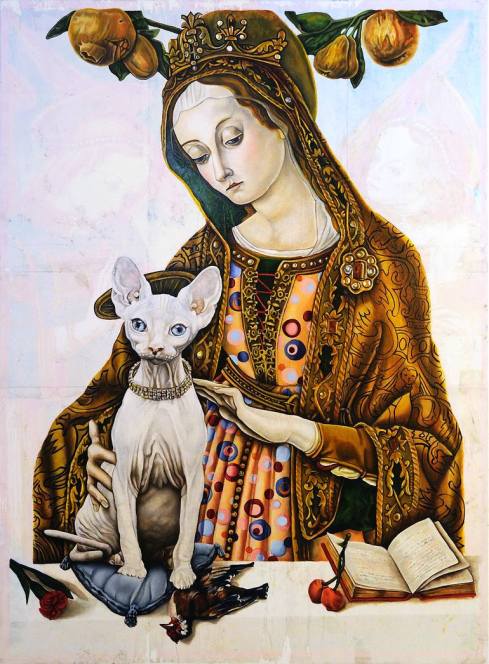
Madonna with Cat
Walking into Leslie Glenn Damhus’ studio, one is immediately confronted by the mid Italian Renaissance. Her work is steeped in religious iconography and she borrows extensively from quattrocento imagery. The attributions of the saints figure largely in her compositions alongside hairless cats and dogs, humming birds and other creatures, fruits and vegetables. As a child she was both attracted to and repelled by the powerful imagery of Hieronymus Bosch’s Garden of Earthly Delights to the extent that looking at it felt like an illicit pleasure. This duality, this exploring of contrasts has become a hallmark of her work. She mixes the sacred and the profane, the serious with the playful, the significant with the trivial.
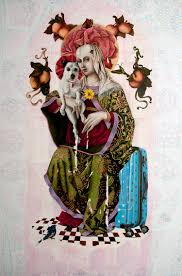
‘Madonna, the Terrier and Suitcase’
2016
Oil on board, 80 x 120cm
Glenn Damhus is something of a magpie gathering images and ideas from many sources, appropriating and reimagining them and then creating collages of these disparate ingredients on her computer. She is passionate about the work of Carlo Crivelli, in particular The Lenti Madonna c.1480. Jacopo di Pontormo is another source. Her work also cites contemporary cultural references, which she inserts into her outwardly serious Renaissance settings with a wry smile.
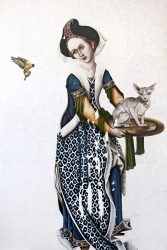
‘Salome with cat and bird’
2017
Oil on board, 80 x 120cm
Her dinner plate halos are a quote from Ronald Lightbown’s monograph on Crivelli where he describes halos as looking like ‘golden plates’. The knitted pussy hats sported by both the Madonna and the cat in Winter 2017, are an obvious Trump reference and appealed to her sense of the ridiculous. Referencing current social and political concerns, she slips in polka dot backgrounds, a gaudy piece of cabin baggage that becomes a seat in Madonna the Terrier and the suitcase and the Hadron Collider which makes an appearance as another halo in the Madonna and chimp Altarpiece.
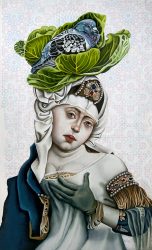
Cabbage and Pigeon
2018
Oil on board, 30 x 50cm
Growing up in the United States, she was introduced to the history of art by her mother, but it was only when she came to the UK and explored the National Gallery’s extensive collection of Crivelli’s, that it became an obsession. She quotes endlessly from his work, taking part of a torso, a headdress or using his sensuous decorative fruits as a motif. Crivelli is an interesting choice in that, although Italian, his very detailed descriptions of nature seem to have an affinity with the works of the Northern Renaissance.
Leslie’s love of fabrics is another gift from her mother who was a superb seamstress. She notes that the clothes in Renaissance paintings were contemporary in their time and that she is merely following the lead of those masters in giving her paintings a contemporary slant. Many religious Renaissance paintings were also not quite what they seemed, another dichotomy echoed by Glenn Damhus. They were frequently an excuse for the celebration of female beauty for the delight of the patrons who commissioned them they also celebrated the wealth and status of those rich nobles and wealthy merchants.
Leslie’s historical ‘quotes’ are selective and sit alongside contemporary edgy comments on the nature of representational art, portraiture, politics and the human condition. Her faces are those of twenty first century women and she frequently uses her own eyes. She is not afraid to shock. For her degree show at UWE she painted a large altarpiece of the Madonna but instead of a child she holds in her arms a naked monkey. She says that she was not being deliberately provocative although she was delighted that her work was seen as controversial. Shown at the Black Swan Open in Frome the following year a deputation requested that the painting be removed from the show. However in a subsequent panel discussion it transpired that some of those objecting had not actually seen the work and once they became aware that this was not a blasphemous representation of the Virgin Mary they rescinded their objections.
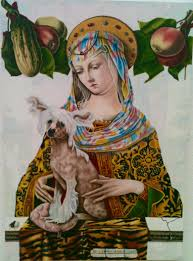
Madonna and dog
Glenn Damhus’ process is intriguing. Following her initial research and the creation of a visual collage on her computer, she lays down a printed background. Then she works in oils on board using tiny brushes. Church altarpieces were usually painted in tempera on board and it is a surface that perfectly suits her way of working. Her printed under-painting is often damaged in the process of laying it down referencing the way in which parts of frescoes peel away as they gradually disintegrate. This deliberate seceding of control over the surface avoids the danger of perfection. Again it becomes apparent that nothing is quite what it seems. The huge disparity in the scale of her work and the size of her brushes, the search for perfection versus the embracing of serendipity all point to her fascination with contrasts.
© Fiona Robinson 2018
Article originally published in Evolver Magazine
Great piece of writing! I can appreciate her work even though I don’t warm to it!
XXP
>